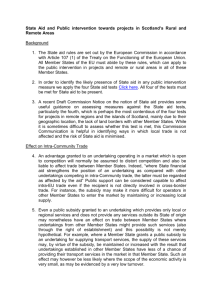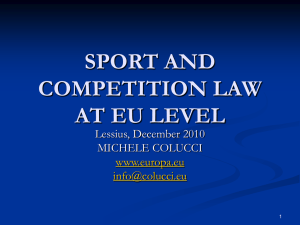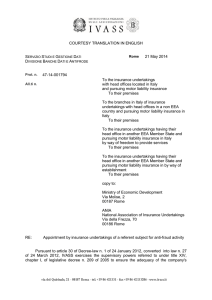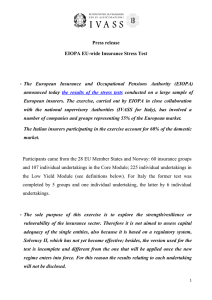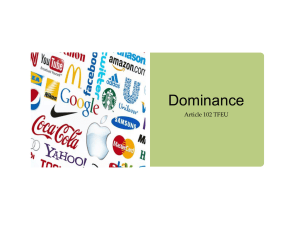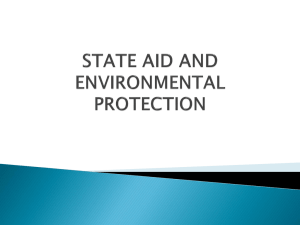2007 - Case Study - Information Exchange in Paper Market
advertisement
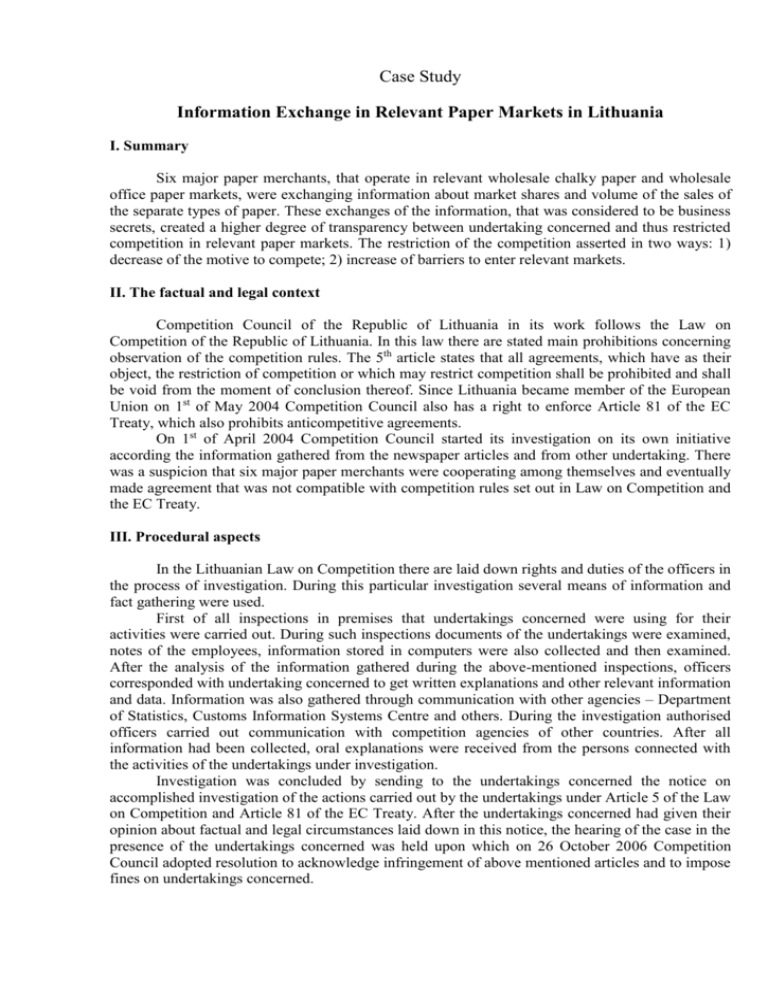
Case Study Information Exchange in Relevant Paper Markets in Lithuania I. Summary Six major paper merchants, that operate in relevant wholesale chalky paper and wholesale office paper markets, were exchanging information about market shares and volume of the sales of the separate types of paper. These exchanges of the information, that was considered to be business secrets, created a higher degree of transparency between undertaking concerned and thus restricted competition in relevant paper markets. The restriction of the competition asserted in two ways: 1) decrease of the motive to compete; 2) increase of barriers to enter relevant markets. II. The factual and legal context Competition Council of the Republic of Lithuania in its work follows the Law on Competition of the Republic of Lithuania. In this law there are stated main prohibitions concerning observation of the competition rules. The 5th article states that all agreements, which have as their object, the restriction of competition or which may restrict competition shall be prohibited and shall be void from the moment of conclusion thereof. Since Lithuania became member of the European Union on 1st of May 2004 Competition Council also has a right to enforce Article 81 of the EC Treaty, which also prohibits anticompetitive agreements. On 1st of April 2004 Competition Council started its investigation on its own initiative according the information gathered from the newspaper articles and from other undertaking. There was a suspicion that six major paper merchants were cooperating among themselves and eventually made agreement that was not compatible with competition rules set out in Law on Competition and the EC Treaty. III. Procedural aspects In the Lithuanian Law on Competition there are laid down rights and duties of the officers in the process of investigation. During this particular investigation several means of information and fact gathering were used. First of all inspections in premises that undertakings concerned were using for their activities were carried out. During such inspections documents of the undertakings were examined, notes of the employees, information stored in computers were also collected and then examined. After the analysis of the information gathered during the above-mentioned inspections, officers corresponded with undertaking concerned to get written explanations and other relevant information and data. Information was also gathered through communication with other agencies – Department of Statistics, Customs Information Systems Centre and others. During the investigation authorised officers carried out communication with competition agencies of other countries. After all information had been collected, oral explanations were received from the persons connected with the activities of the undertakings under investigation. Investigation was concluded by sending to the undertakings concerned the notice on accomplished investigation of the actions carried out by the undertakings under Article 5 of the Law on Competition and Article 81 of the EC Treaty. After the undertakings concerned had given their opinion about factual and legal circumstances laid down in this notice, the hearing of the case in the presence of the undertakings concerned was held upon which on 26 October 2006 Competition Council adopted resolution to acknowledge infringement of above mentioned articles and to impose fines on undertakings concerned. 2 IV. Competition analysis Market structure During the investigation two types of paper – chalky paper and office paper – were analyzed. These two types of paper are used for different purposes: chalky paper is used for printing of magazines, books, maps and other similar products; meanwhile office paper is used for printers, copiers, faxes, other office machines and for other office needs. Therefore these two types of paper from customers point of view were not considered to be appropriate substitutes to each other and to other types of paper (for example, carton) according to their characteristic and application. Furthermore, according to the differences following from the manner of trade, such as buyers needs, amount of sales to every buyer, there were distinguished wholesale paper market and retail sale paper market. Since the investigation was initiated in regard to the undertakings that were operating in wholesale paper markets and the territory of their activities was limited to the territory of the Republic of Lithuania, there were defined two relevant markets: wholesales of the chalky paper in Lithuania relevant market and wholesales of the office paper in Lithuania relevant market. Competition Council concluded, that above mentioned relevant markets during period from 1999 to 2004 were oligopolistic relatively concentrated markets. This conclusion was made in consideration of market shares of the undertakings that were operating in relevant paper markets. It was determined, that during investigation period, there were approximately up to 20-31 undertakings operating in relevant chalky paper market and approximately up to 25-40 undertakings operating in relevant office paper market. Six biggest undertakings, operating both in chalky and office paper markets, together covered up to 94 % of the chalky paper market and 97 % of the office paper markets, each of them holding relatively big market shares. Meanwhile each of other small undertakings was holding averagely market shares that didn’t amount to 1 %. Despite variations of the market shares among six major paper merchants (sometimes up to 10 %), basically these variations didn’t affect the structure of the relevant paper markets: all six biggest merchants maintained their relatively big market shares, whereas all small paper merchants didn’t succeed in obtaining bigger market shares. It must be pointed out, that one of the major paper merchant was established and began its activity only in 2001, while investigation period had started in 1999. This undertaking within its first year succeeded in gaining market share up to 10 %. The entrance of this undertaking could have been considered as the only sufficient entry of the competitor of the undertakings that previously had been holding the largest part of the relevant markets. However this example was not considered as indicator that the entry into relevant markets was easy for other undertakings. First of all this undertaking was the member of the information exchange, as a result it had better knowledge of the situation in relevant markets. It was also important that the director of this undertaking had been taking part in earlier information exchanges as the head of the other paper merchant, so he had paper trading experience. Consequently other small undertakings, which entered the relevant markets during the investigation period without having advantage of the detailed information about relevant paper markets that was possessed by the major six merchants, experienced difficulties in successful development and didn’t succeed in gaining significant market shares. In summary it can be said that during investigation period there were no significant entries of competitors in relevant paper markets. Information structure of the market There is no association of paper merchants in Lithuania, nor there was any during the investigation period. In 2003 was established Baltic Association of Paper Merchants in Latvia (Riga), which unified paper merchants from all over the Baltic States. This association collected information about its members, but the information that could be received was of general statistical nature. General statistical information was also available from the public articles, where annual reports were published. 3 In this particular case, related to information exchange as the violation of competition rules, it must be pointed out, that during the investigation period information concerning quarterly data about individual market shares and volume of sales was not publicly anyhow available. Undertakings that were wishing to observe their market share variations and to know their actual position in the market could receive that kind of information only by entering into contract with market research companies. But undertakings even from these companies could not receive information about their competitors. Nature of the actions exercised by the undertakings concerned In the circumstances mentioned above, undertakings concerned – six biggest paper merchants – agreed to exchange among themselves data received from the research company concerning their individual market share and volumes of sales on the quarterly basis. Thus was created information exchange system, whose members were only six major paper merchants and which was closed from other small paper merchants. In 1999 undertakings concerned were arranging periodical meetings every quarter of the year during which market shares were also discussed. From the evidence, collected during the investigation, the conclusion was drawn that from the information that had been disseminated during these meetings undertakings concerned were able to be aware of total volume of sales, volume of sales of separate types of paper (chalky paper and office paper) and market shares of the competitors. In 2000, 2001, 2003 and 2004 undertakings concerned entered into contracts with the market research company. The research company committed itself to carry out paper market researches and every three-month to provide each undertaking with the data related to volume of total paper sales, total sales of separate types of paper and individual market share of the undertaking among surveyed undertakings. In consequence undertakings concerned periodically were receiving information about past quarter of the year individual market shares, total paper sales and total sales of separate types of paper. After receiving from market research company information about individual market shares, each of the undertakings concerned used to send its individual figures indicating its market shares in percentage by e-mail messages. Thus every undertaking that was taking part in the information exchange was able to know not only market shares of its rivals, but also their volume of total sales and volume of sales of different types of paper (chalky and office paper). Considering the fact, that undertakings concerned were used to exchange information on quarterly basis, they were able to observe and to analyse alterations of the market shares, volume of sales of every single major competitor and the dependency of market shares variations on changes of the sales volume. Effect on competition For the assessment of the actions of the undertakings concerned, it was considered to be important several circumstances – the structure of the relevant chalky paper and office paper markets, nature of the information that undertakings had been exchanging, the periodicity and frequency of the information exchanges. The Competition Council had concluded that periodical and frequent exchange of the information of the confidential nature in the oligopolistic relatively highly concentrated market contravened competition rules by restricting competition in relevant paper markets in two ways: 1) decreasing the motive to compete; 2) increasing barriers to enter relevant markets. 1) Decrease of the motive to compete was deduced as the conclusion of the increase of the transparency in relevant paper markets. Information exchange restricted the competition because it had created a higher degree of market transparency between six major rivals in oligopolistic relatively highly concentrated paper markets. When there was a sufficient degree of transparency, it was much easier for the undertakings to follow the actions of their competitors and to react to these actions more quickly than they could have reacted in the absence of the information exchange. In 4 these circumstances, undertaking, which initiates its effective competitive actions (for instance, reduction of prices to increase volume of sales and thus to obtain bigger market share in relevant market), would not succeed in gaining any profit from these actions, because the rivals of the initiator would immediately react to these actions and would also, for example, decrease their prices. In that case it is more beneficial to avoid competitive actions because they would be counteracted before they would give any benefit. Thus the Competition Council came to a conclusion, that effective competition is endangered, if biggest competitors in oligopolistic relatively highly concentrated market are able to follow each other’s competitive conduct and to react at once if any initiative of effective actions is spotted. The perception of the situation like this had determined that six biggest paper merchants realized that it was more beneficial for them to avoid intensive competition. Furthermore, the reaction to the rival’s competitive actions would have been limited to the minimum effort by the knowledge of how efficient counteract should have been that desirable objective would be reached, for example, how big discounts must be made, that sales volumes and market share would be maintained. In summary it can be stated, that competition in the relevant paper markets would have been more active in the absence of the information exchange, thus the restriction of competition necessarily result from information exchange that increases degree of transparency in oligopolistic relatively highly concentrated relevant paper markets. 2) The information exchange also restricted competition between members and nonmembers of the exchange. Other small paper merchants, which didn’t take part in the exchange of the information about market shares and volume of sales, got into disadvantageous situation by the fact that they didn’t have the advantage in respect of the market information comparing to undertakings that took part in the information exchange. That kind of information about the structure of the relevant paper markets enabled undertakings concerned to maintain their shares and position in the markets much easier in comparison to undertakings that didn’t have this information. The disadvantage of the non-members resulting from the information exchange evidences in several ways. If other undertaking wishes the information to be available for it, it must disclose its own sales volumes and other information of confidential nature. On the other hand, thus the members of the exchange are able to track the intentions of the new member to expand its market share and undertake appropriate measures to suppress its possible expansion. In the same way the new entry into the market can also be detected. On all occasions from information exchange would have benefited only undertakings that already were members of the exchange. Consequently the Competition Council concluded that, the information exchange provided to the undertakings concerned the ability to prevent much easier new undertakings from entries to the paper markets or other small undertakings from development of their activities. Thereby information exchange among major competitors in the oligopolistic relatively highly concentrated paper markets by itself increased the barriers to entry because the members of the exchange were enabled to notice at once the penetration of the new entry into the market or any increase of sales of the undertaking that didn’t take part in the exchange and thus the members of the exchange were able to react appropriately to defend their position. Situation like this necessarily resulted in the restriction of the competition in the relevant paper markets. In this particular case, it was the structure of the market and the nature of the information exchanged which all led to the conclusion that restriction of competition as a result of the information exchange was inevitable. It is important to notice that relevant chalky paper and office paper relevant markets were considered to be national markets. Thereby the information exchange, that restricted competition in whole Lithuanian territory and also increased barriers to entry, eliminated Lithuania’s paper trading market from the common market of the European Communities because the trading and competition pattern in Lithuania was perverted. Thus competition in whole common market was affected. 5 Evidence The information exchange was determined from the evidences that were collected during the inspections in the premises of the undertakings concerned. The exchange was confirmed by the notes, which had been found in the notebooks of the director of the undertaking concerned, and by the e-mail messages, that had been found in the computers of the undertakings. It must be pointed out, that undertakings didn’t argue that they had been exchanging information identifying their market shares and sales volumes, so there were no considerations about the sufficiency of proofs. V. The outcome In conclusion, the Competition Council made a resolution, that by exchanging information identifying market shares and volumes of the sales six major paper merchants in the oligopolistic relatively highly concentrated paper markets in Lithuania infringed competition rules stated in the Law on Competition of the Republic of Lithuania and in the EC Treaty. The member of this information exchange were fined and obliged to refrain from that king of information exchange in the future. Since in the Law on Competition there is established the right to appeal against the resolution of the Competition Council, two undertakings brought their complaints to the Vilnius Regional Administrative Court. They have argued, that the kind of information exchange, which they used to exercise, in no way could have distorted competition and the resolution of the Competition Council is therefore unlawful. The hearing of the court has not been held yet.
